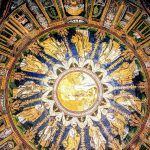External
The Baptistery is a building with a central plan, octagonal in shape, with 4 lobes that correspond to the apses, arranged in an X shape. The body is an octagonal tower that has the function of a lantern (enclosing a dome visible from the inside) and a pyramidal roof .
Overall it is very simple, the only decoration and is built in brick.
The octagonal shape of the Byzantine baptisteries has a strong symbolic value. The number eight on the sides corresponds, in fact, to the seven days of the creation of the world and to the eighth day: that of the resurrection and of eternal life. It is therefore clearly connected to the sacrament of Baptism.
Indoor
In the center is the baptismal font, octagonal, dating back to the Renaissance. At the top is the hemispherical (clay) dome. The original floor is 3 meters below the current one.
The interior of the baptistery has a very rich decoration with mosaics, stuccos and marble incrustations which creates a particularly suggestive atmosphere.
The dome is entirely decorated with mosaics. On the whole there is a dynamic effect of rotation due to the movement of the apostles, presented as they walk in two processions, alternating with the candlesticks.
It is divided into three concentric rings:
1) in the center, a medallion with the Baptism of Christ
2) in the middle ring, the Procession of the Twelve Apostles
3) in the outermost ring, the Symbols of the Final Judgment.
The Baptism of Christ
The Savior is presented frontally and is immersed up to his hips in the waters of the Jordan; the Baptist (left), standing on the bank of the river, he is seen in profile and is caught in the act of pouring water on the head of Christ, on whose perpendicular a dove with spread wings, symbol of the Holy Spirit.
From the waters emerges, on the right, the pagan personification of the Jordan River, identified by the abbreviated inscription IORDAN (US) N (UMEN), that is Nume (deity) of the Jordan.
This shows how difficult it is to completely abandon the traditional iconography that the abundant imperial artistic production had come to spread to the extreme domains of Rome and beyond.
The scene is composed with a few essential and naturalistic elements: the rocks, the plants, the solid bodies full of volume, are all elements of a still classical style. There are also some very interesting light effects: the transparency of the water and the shine of the wet body of Christ: very difficult to render with the mosaic.
A certain naturalism therefore constitutes the first characteristic that we notice.
However, the sky is a golden background. It symbolically represents the glory of Heaven. To prevent the outlines of the characters from getting lost against that unreal sky, the artist underlined them with a strong red line. In this way the bodies are somewhat deprived of their volume, since the continuous line has above all the function of underlining the design, that is the two-dimensionality.


